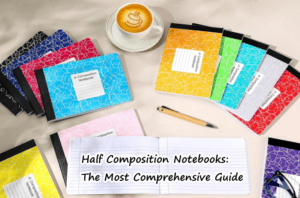Are you planning to order notebooks in large quantities? If yes, the page numbers per notebook are an important feature to plan for. Read our FAQs to learn about notebook page numbers and why they are so important.
1. Why do page numbers matter?
Notebook page numbers matter because they impact the overall size and weight of the notebook. The more sheets a notebook has, the more pages it will have, and buyers are always making purchase decisions based on economic value and weight. As a supplier or retailer of notebooks, you must find the right balance between weight and size.
Most people prefer notebooks with several pages, as those with fewer pages will be quickly exhausted. However, they also don’t want notebooks that are too heavy and bulky. Notebook page numbers always and will continue to be a major factor for buyers; that is why they matter.
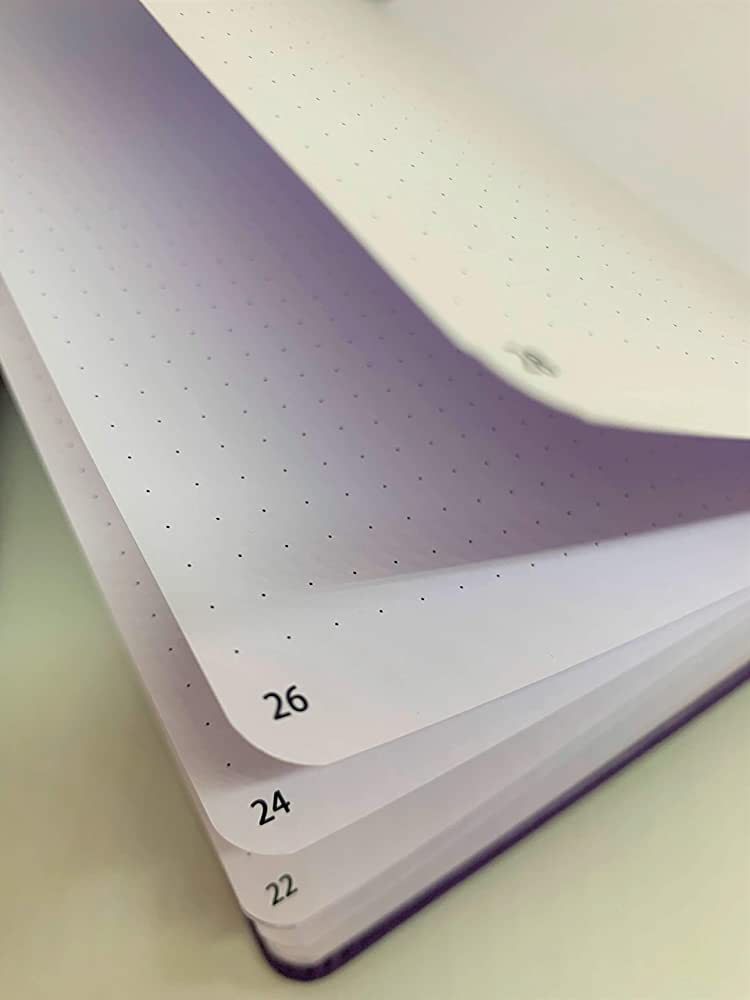
2. Differences between pages and sheets
There is a lot of misconception and confusion between sheets and pages because both terms have been used interchangeably. However, both terms are different in their meaning. A sheet is a material you write in; every sheet has two sides (two pages). On one side is a page and on the other side is another page. If the sheet is then folded into two, it becomes four pages. If two folded sheets are joined together, they become eight pages.
| 1 sheet = 2 pages | 1 folded sheet = 4 pages | 2 folded sheet = 8 pages |
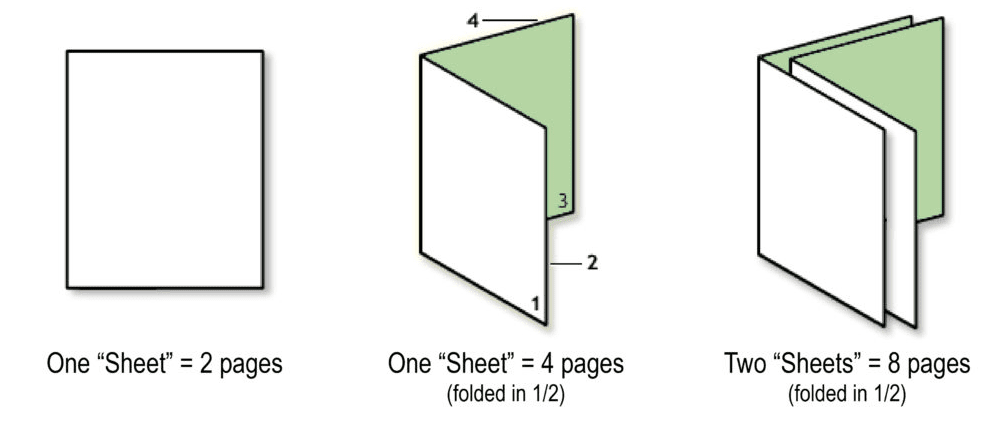
Notebooks are actually several single folded sheets attached to a cover.
- In the case of the first illustration, a single sheet has two sides, with one side called page 1 and the second side called page 2.
- In the second illustration, the sheet folded into four places has one side facing outward as the front cover, the inside as the inside front, the other side as page 3, and the last side as the back cover.
- As for the last illustration, two folded sheets form eight pages once they are bonded.
If you want to know more, please click Notebook Inner Page: The Ultimate FAQ Guide.
3. Common notebook page numbers
Some notebook page numbers are quite popular, and they all happen to be even numbers, not odd numbers. Let us look at some common notebook page numbers in use today.
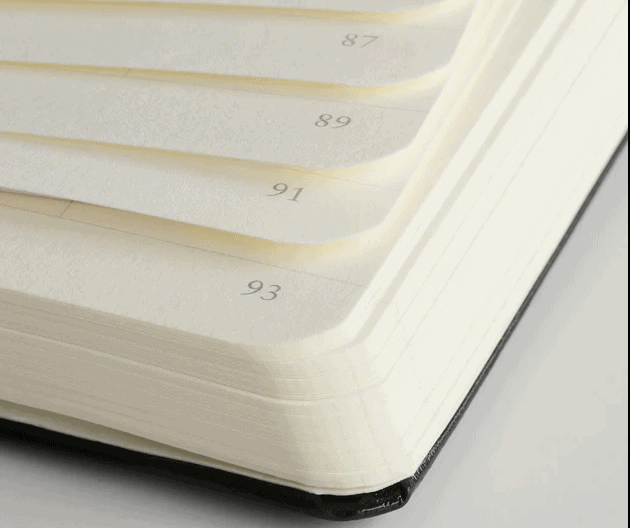
- 40 pages: This one is commonly used by kids in elementary school just starting their education proper. The 40-page notebook is the notebook of choice because it is lighter and cheaper. Toddlers who are just learning to read and write will often mess up their sheets due to rough handling, so parents prefer to give them relatively cheap writing material that costs little
- 192 pages: Notebooks with 192 pages is the standard notebook of choice in many countries. They are used for copying notes, writing lists, preserving data, and any other thing you can think of. Students in middle school commonly use notebooks with this number of pages because they take a long to exhaust all pages.
- 100 pages: 100-page notebooks are quite popular in many Western countries. They are affordable and offer economic value to those who don’t want to spend too much on materials. Despite being about half the size of 192-page models, they can serve the user well for a relatively short time.
- 200 pages: 200 pages notebooks are commonly used by middle school students in their senior year and college students. If you want a notebook with long-term value, this is an ideal notebook to go for. You have more than enough pages to last for a long time, especially if you use one per subject.
- 96 pages: This is another common notebook page number in use. They are commonly used by older students in primary school.
- 140 pages: For those who don’t want a bulky 192 or 200 notebook but consider a 100-page notebook too small, a 140-page notebook is a compromise. They are lightweight and contain more than enough pages to help you get by.
- 288 pages: These types are bulky notebooks used by storekeepers for record keeping. They are not common among school-going students because of their sheer weight. 288-page notebooks are long-term writing materials for storing bulk data entries daily.
4. Popular notebook page counts in different countries
Different countries prefer different notebook counts for educational and cultural reasons. While some countries prefer smaller and lighter notebooks that are convenient to carry, others place more emphasis on economic value over convenience, especially if notebooks cost a significant sum.
This is normal in countries that import such books. As you may know, imported notebooks tend to be more expensive than locally produced versions, so price influences consumer patterns.
Here are popular notebook page counts per country.
- USA: 70-100 pages
- UK: 80-120 pages
- Canada: 100 pages
- France: 50-80 pages
- Germany: 100/150 pages
- Italy: 110/192 pages
- South Africa: 120 pages
- Nigeria: 80 pages
- South Korea: 60/64 pages
- China: 30-120 pages
- Japan: 30-50 pages
- Australia: 100 pages

5. Why do notebooks typically have 192 pages?
Many remain curious as to why notebooks typically have 192 pages. Although 192 is an even number definitely not a round figure like 100, 150, 200, 300, 500, and so forth. Although notebooks with these page numbers exist, the 192 models appear quite popular, but why?

The reason is simple. Sheets from pages and notebooks are a combination of different sheets. Sheets are folded, stitched, and bound, and since there are two pages in a single sheet, the multiple of 2’s creates the 192 pages that most notebooks have. For example, a single notebook may have 1, 2, 4, 6, 8, 32, or 64 sheets; if they are folded into three, you get a total page number of 192.
So if you come across any notebook with 192 pages or advertised as (almost 200 pages), just know that it is a 64-sheet book folded into three.
6. How to choose page numbers for your order?
If you want to order notebooks in bulk, deciding on the page numbers the notebook should have will determine the success or failure of your business venture. Get it right, and you will be successful; order the wrong page numbers, and you may struggle to sell them, or even if you do, the notebooks will offer users limited value.
One mistake retailers make is to assume that buyers will buy just any notebook they can find, but this is only the case when there is a scarcity of notebooks. If there is an abundance and buyers have a choice, they will become choosy regarding the notebooks they pay for.
So here are the things to consider when choosing page numbers for your order.
User needs
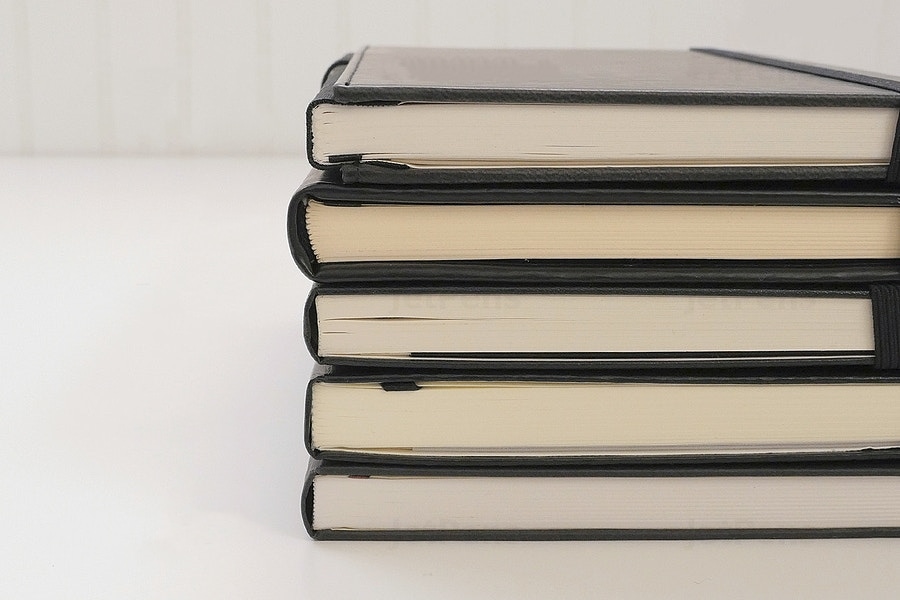
People buy notebooks for different purposes, and the greatest number of notebooks are used by students of all ages, from elementary school to higher institutions. Then there are record keepers, business persons, and others who want material where they can occasionally document their thoughts or information. Before you order, identify the target market you wish to serve.
Remember that buyers buy notebooks that will satisfy their needs. The notebooks students prefer are not the same ones a storekeeper will prefer. While the average student wants a book that contains enough pages but is convenient to carry, a storekeeper will not mind the inconveniences of a bulky notebook as long as it has enough pages for record keeping.
In the case of a business person working in an office, most of the information and data he or she will work with will be in soft computer copies and will only write down the fewer date on paper; such a person may not need a notebook ls with so many pages as long as the sheet is thick and easy to carry.
Budget
Your budget should also influence your decision. Larger notebooks with thin, low-quality sheets may cost less than smaller notebooks with thicker sheets. Before you finalize the order, request the various quality specifications they have and make your choice based on the local market you wish to serve.

If you don’t have a large budget, you should opt for a notebook with fewer pages but good quality paper that the market will value. Never compromise on quality for any reason. Just in case you don’t have an idea – seek the help of a Chinese purchasing agent.
Notebook sizes
When making your choice, the last thing you want is a notebook that will look like a Bible, Dictionary, or Science textbook. So avoid too many pages. If the book contains too many sheets, it will be too bulky to carry. Unless you are looking to order them for record-keeping, it’s preferable to order fewer pages so users can carry them around conveniently. (Notebook Sizes: The Ultimate FAQ Guide)
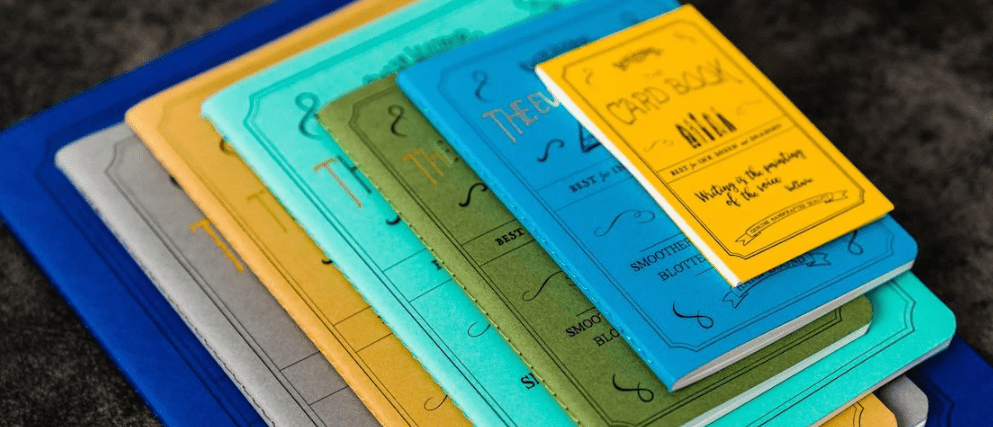
Affordability
Consider the purchasing power of the market niche you wish to serve. No matter how good your notebooks are or how many pages they have, if they are too expensive for the average user, you will not sell them as quickly as you wish. So affordability should be considered when you do your market research. What is the current market price of a notebook in your area? Consider the average price, lowest price, and highest price, then identify a price scale you can sell for without sacrificing profit margins.

Shipping cost
You should also consider shipping costs if the notebook manufacturer is not based in your country. Shipping companies charge freight fees based on the weight of the cargo, so the heavier the cargo, the higher the freight cost. So before you place an order for a particular amount of notebooks, factor in the freight cost to the final cost.
For instance, a 100-page notebook will not weigh as much as a 192-page notebook. While a single or a few dozen notebooks may not weigh too much, hundreds or thousands of them will. So before you place your order, factor in shipping and transport costs from the point of production to the delivery point (your warehouse or shop).

These factors should not be considered in isolation, but comprehensively so you can arrive at suitable page numbers for your notebooks so you can break even and make a profit at the end of the day.
Conclusion
Notebook page numbers matter from the supply and demand side, so the decision should not be treated with kid’s gloves. Do your market research and factor in the production cost, shipping cost, and the average market price per unit in your area. Also, factor in the demand trends in your target market. It is only after you have done this that you should place an order for notebooks.


